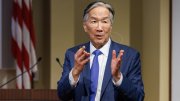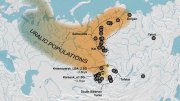In 1900, mathematician David Hilbert drew up a list of 23 hard problems in his field; 110 years later, just 10 have been fully solved.
When Hilbert wrote his list, such problems as why humans don’t always make choices that are good for their health, or why they tend to form social groups in particular patterns, were thought to be the domain of philosophy or psychology--explicitly not scientific.
But since then, the social sciences have come to rely more and more on statistics and other quantitative approaches, and new methods (for instance, advances in statistics and genetics) have enabled solving social-science problems with more precision. This convergence of circumstances allows social scientists today to ask their fields’ biggest questions--and hope to answer those questions definitively. And so a dozen prominent scholars gathered at Harvard on April 10. Invited by Faculty of Arts and Sciences (FAS) social sciences dean Stephen M. Kosslyn, Lindsley professor of psychology, and sponsored by the Connecticut-based Indira Foundation (which seeks to benefit the fields of education, healthcare, and social welfare), they were tasked with choosing one big problem (or a few) to present in a quarter-hour or less. Their choice was to be based on two criteria: a problem’s difficulty, or how long it has persisted unsolved; and its importance--the urgency, and potential payoff, of solving it.
Several speakers noted the differences between Hilbert’s domain and their own, where problems are often messier and less well defined. In fact, the problem highlighted by Morris professor of psychology Susan Carey related to this overarching issue. “How,” she asked, “can you create new knowledge when you don’t even have the resources to represent the knowledge you seek to create?” She noted that many of the problems her colleagues raised “are problems where we don’t really know how to think about the question.”
The problem chosen by University of California, Berkeley sociology professor Ann Swidler ’66 was one of those. Swid-ler called for studying how societies create institutions, and how they restore missing or damaged ones. She previewed the complexity inherent in framing the problem by listing just a few of a huge range of entities and phenomena that qualify as institutions: governments, universities, and marriage.
Several presenters issued open challenges to apply new methods and techniques--notably, Nicholas Christakis (professor of medical sociology and of medicine at Harvard Medical School and professor of sociology in the Faculty of Arts and Sciences [FAS]) and James Fowler ’92, Ph.D. ’03 (a political scientist at UC, San Diego), who have written a book together (see “Networked,” May-June, page 44). Christakis voiced hopes that, given advances in genetics, biology and sociology will soon converge to explain how the social becomes biological: to explain, for instance, the evolutionary basis for phenomena such as emotional contagion (the way one person’s mood can “rub off” onto another). Fowler called for the development of methods to explain clustering in social networks--to differentiate homophily (people’s tendency to choose friends like themselves) from influence (friends adopting behaviors from other friends in cause-and-effect fashion).
Other presenters pointed to areas where methodological solutions do not yet exist, but are needed. Nassim Taleb, a professor at New York University and Oxford and author of The Black Swan: The Impact of the Highly Improbable, noted that economists and statisticians have no way to account for extremely rare events such as financial meltdowns. Precisely because they are so unlikely and occur so rarely, there is no way to incorporate them into mathematical models with any degree of accuracy. And Weatherhead University Professor Gary King, who directs Harvard’s Institute for Quantitative Social Science, called for addressing “post-treatment bias in big social-science questions”--the difficulty in using statistical methods to study the real world (as opposed to controlled experiments in a laboratory setting) without inadvertently controlling for a variable that is directly related to the outcome the study is trying to measure.
Two presenters called for a reversal of the current way of thinking about a problem. Oxford philosopher Nick Bostrom challenged the academic community to identify the biggest fallacies that are accepted as common knowledge today--ideas analogous to such past misconceptions, once widely believed, as the view that there are no inborn differences in personality or intelligence, or that some races are incapable of “higher civilization.”And Peter Bearman, Ph.D. ’85, a sociologist at Columbia, noted that even though academia focuses on change, what may be more interesting is the continuity of certain aspects of the human experience--our inability to eradicate violence, for instance. (A family emergency kept Bearman away, so Ford professor of the social sciences Robert J. Sampson gave the presentation for him.)
Several of the problems fit neatly into the category Bearman highlighted: problems that are vexingly persistent through time. Ramsey professor of political economy Richard Zeckhauser discussed the difficulty in engineering systems (political and otherwise) that balance the preferences of their constituents. Lee professor of economics Claudia Goldin called for further research on the problem of why women are still paid less than men. Beren professor of economics Roland Fryer drew attention to the racial achievement gap in American education. And Emily Oster ’02, Ph.D. ’06, focused on the tricky task of getting people to change their health behaviors. Oster, an assistant professor of economics at the University of Chicago, noted that newly diagnosed diabetics who are very obese gain more weight in the year following their diagnosis than do similarly sized people who are not diabetic--contrary to the expectation that the diagnosis would cause the first group to take better care of their health and lose weight.
The symposium ended with a call for the public to weigh in on which of the problems were most pressing and which were most worthy of investing effort in solving--and to suggest their own problems to add to the list. Voting was scheduled to close May 31, with the final tally announced thereafter. At this writing, a vibrant discussion of several of the problems was still under way on Facebook. Check back at harvardmagazine.com/hardproblems for updates on the voting and plans to publish the symposium proceedings as a guide for future work in Harvard’s large social-sciences faculties and elsewhere.









